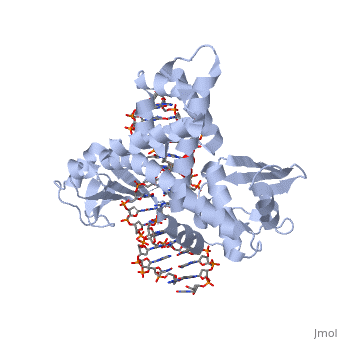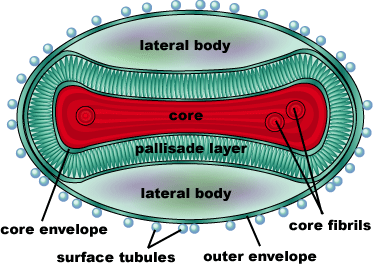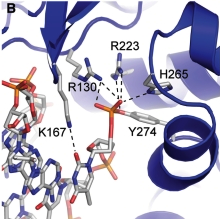Smallpox (Variola Virus) - Topoisomerase 1B
From Proteopedia
| Line 1: | Line 1: | ||
== Smallpox (Variola Virus) - Topoisomerase 1B == | == Smallpox (Variola Virus) - Topoisomerase 1B == | ||
| - | Smallpox is an acute, highly contagious disease, which causes disfiguring and febrile rash-like illness, which has no known cure. According to some health experts, smallpox was responsible for more deaths than all other infectious diseases combined thus far in the world's history <ref name="Smith">Smith, K. “Smallpox. can we still learn from the journey to eradication?” Indian Journal Of Medicine. 137.5 (2013): 895-899.</ref>. The disease causes high morbidity and mortality and led to the deaths of approximately 500 million people in the 20th century alone. <ref name="Smith">Smith, K. “Smallpox. can we still learn from the journey to eradication?” Indian Journal Of Medicine. 137.5 (2013): 895-899.</ref>. With so many people affected, in an intensive public health vaccination campaign was initiated by the World Health Organization (WHO) to eradicate smallpox as a human disease in the 1960’s. <ref name="Smallpox">“Smallpox.” Center for Disease Control and Prevention. CDC, n.d. Web. 28 Oct. 2015. <http://www.bt.cdc.gov/agent/smallpox/index.asp></ref>. There were two forms of the disease worldwide: Variola major, the deadly disease, and Variola minor, a much milder form <ref name="Smallpox">“Smallpox.” Center for Disease Control and Prevention. CDC, n.d. Web. 28 Oct. 2015. <http://www.bt.cdc.gov/agent/smallpox/index.asp></ref>. Although naturally occurring smallpox no longer exists, there are concerns that the variola virus could be used as an agent of bioterrorism or biowarfare. As a result, it is critical to understand the molecular dynamics and virulence factors in order to prepare for a potential epidemic and to prevent the devastating consequences <ref name="Smallpox" />. | + | Smallpox is an acute, highly contagious disease, which causes disfiguring and febrile rash-like illness, which has no known cure. According to some health experts, smallpox was responsible for more deaths than all other infectious diseases combined thus far in the world's history <ref name="Smith">Smith, K. “Smallpox. can we still learn from the journey to eradication?” Indian Journal Of Medicine. 137.5 (2013): 895-899.</ref>. The disease causes high morbidity and mortality and led to the deaths of approximately 500 million people in the 20th century alone. <ref name="Smith">Smith, K. “Smallpox. can we still learn from the journey to eradication?” Indian Journal Of Medicine. 137.5 (2013): 895-899.</ref>. With so many people affected, in an intensive public health vaccination campaign was initiated by the World Health Organization (WHO) to eradicate smallpox as a human disease in the 1960’s. <ref name="Smallpox">“Smallpox.” Center for Disease Control and Prevention. CDC, n.d. Web. 28 Oct. 2015. <http://www.bt.cdc.gov/agent/smallpox/index.asp></ref>. There were two forms of the disease worldwide: Variola major, the deadly disease, and Variola minor, a much milder form <ref name="Smallpox">“Smallpox.” Center for Disease Control and Prevention. CDC, n.d. Web. 28 Oct. 2015. <http://www.bt.cdc.gov/agent/smallpox/index.asp></ref>. Although naturally occurring smallpox no longer exists, there are concerns that the variola virus could be used as an agent of bioterrorism or biowarfare. As a result, it is critical to understand the molecular dynamics and virulence factors in order to prepare for a potential epidemic and to prevent the devastating consequences <ref name="Smallpox" />. See also [[Variola Topoisomerase 1B]] |
<StructureSection load='3igc' size='350' side='right' caption='Structure of Variola Topoisomerase 1B with DNA (PDB entry [[3igc]])' scene=''> | <StructureSection load='3igc' size='350' side='right' caption='Structure of Variola Topoisomerase 1B with DNA (PDB entry [[3igc]])' scene=''> | ||
Current revision
Smallpox (Variola Virus) - Topoisomerase 1B
Smallpox is an acute, highly contagious disease, which causes disfiguring and febrile rash-like illness, which has no known cure. According to some health experts, smallpox was responsible for more deaths than all other infectious diseases combined thus far in the world's history [1]. The disease causes high morbidity and mortality and led to the deaths of approximately 500 million people in the 20th century alone. [1]. With so many people affected, in an intensive public health vaccination campaign was initiated by the World Health Organization (WHO) to eradicate smallpox as a human disease in the 1960’s. [2]. There were two forms of the disease worldwide: Variola major, the deadly disease, and Variola minor, a much milder form [2]. Although naturally occurring smallpox no longer exists, there are concerns that the variola virus could be used as an agent of bioterrorism or biowarfare. As a result, it is critical to understand the molecular dynamics and virulence factors in order to prepare for a potential epidemic and to prevent the devastating consequences [2]. See also Variola Topoisomerase 1B
| |||||||||||
References
- ↑ 1.0 1.1 1.2 Smith, K. “Smallpox. can we still learn from the journey to eradication?” Indian Journal Of Medicine. 137.5 (2013): 895-899.
- ↑ 2.0 2.1 2.2 2.3 2.4 “Smallpox.” Center for Disease Control and Prevention. CDC, n.d. Web. 28 Oct. 2015. <http://www.bt.cdc.gov/agent/smallpox/index.asp>
- ↑ 3.0 3.1 3.2 Shubhash, and Parija. "Poxviruses." Textbook of Microbiology and Immunity. Ed. Chandra. India: Elsevior, 2009. 484. Print.
- ↑ 4.0 4.1 4.2 4.3 4.4 4.5 4.6 4.7 Berwald, Juli. "Variola Virus." Encyclopedia of Espionage, Intelligence, and Security. 2004.Encyclopedia.com. 28 Oct. 2015 <http://www.encyclopedia.com>
- ↑ 5.0 5.1 5.2 "PENN Medicine News: Penn Researchers Determine Structure of Smallpox Virus Protein Bound to DNA." PENN Medicine News: Penn Researchers Determine Structure of Smallpox Virus Protein Bound to DNA. PENN Medicine, 4 Aug. 2006. Web. 28 Oct. 2015. <http://www.uphs.upenn.edu/news/News_Releases/aug06/smlpxenz.htm>
- ↑ Perry, Kay, Young Hwang, Frederic D. Bushman, and Gregory D. Van Duyne. "Insights from the Structure of a Smallpox Virus Topoisomerase-DNA Transition State Mimic." Structure (London, England : 1993). U.S. National Library of Medicine, n.d. Web. 28 Oct. 2015. <http://www.ncbi.nlm.nih.gov/pmc/articles/PMC2822398/>
- ↑ 7.0 7.1 7.2 Minkah, Nana et al. “Variola Virus Topoisomerase: DNA Cleavage Specificity and Distribution of Sites in Poxvirus Genomes.” Virology 365.1 (2007): 60–69.PMC. Web. 16 Nov. 2015
- ↑ 8.0 8.1 8.2 8.3 8.4 8.5 8.6 Baker, Nicole M., Rakhi Rajan, and Alfonso Mondragón. “Structural Studies of Type I Topoisomerases.” Nucleic Acids Research 37.3 (2009): 693–701. PMC. Web. 16 Nov. 2015>



